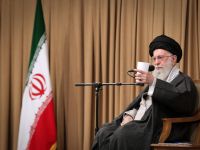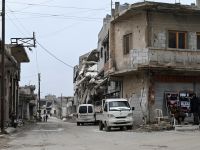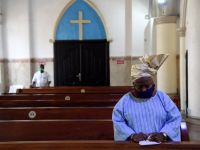Wael Kodeih’s latest project “DABAKA” reinvents the Levantine folklore with a contemporary edge.
Performed at The Grand Factory an hour late Tuesday night, the audience quickly forgot the delay when the concert began, dancing along to the traditional dabke rhythms mixed through techno, rock and disco melodies.
Funded by the U.N. agency for refugees and organized with the support of cultural NGO Red Oak, the project unites Lebanese and Syrian artists around a promised audiovisual performance.
Kodieh, a longtime player in the Arabic urban music scene (once known as rapper Rayess Bek), was joined by electro-tarab producer Samer al-Daher (aka Hello Psychaleppo), who used a synthesizer in lieu of a tabla or other Arabic instruments, bassist/vocalist Khaled Omran from the band Tanjaret Daghet and guitarist/vocalist Wassim Bou Malham from Who Killed Bruce Lee. The project has also resulted in a four-track EP, offering a slightly more polished version of the compositions, which were performed live with healthy dose of bass and distortion.
“The idea was to go beyond boundaries because when you’re onstage you’re a musician first before being whatever nationality you are,” Kodieh said before the concert. “Music is a language and dialogue and we managed to find a dialogue between the people onstage with the video.
“Dabke is a traditional music that comes from Syria, Lebanon, Jordan and Palestine, and the idea was to take this heritage and take it somewhere else,” he added.
“Don’t be shocked if you don’t recognize the dabke today.
“And we used dabke from different areas from the Sham, Kurdish dabke, from Baalbeck and made something new with it.”
Behind the performers were screens playing a video created by Joan Baz, the visual component of the project.
The piece shows one dabke dancer at a time in slow motion, repeated to look like a full troupe.
As many expected a dabke dance performance, the visuals left something to be desired. As it is, the performance is simply a regular, modern-day concert with relevant images played on a brightly lit screen.
The music itself, however, was an excellent example of Western-Eastern fusion, which had the packed crowd starting their own dabke lines where possible. The Arabic rhythms blended harmoniously with the electronic melodies. Some of the tracks used the vocals of traditional Arabic songs sung over the top, while others were completely instrumental.
The different musical styles kept things from sounding similar, as each track had a different flavor to the melodies used. The EP’s third track, “Ya Nass,” weaves heavy electric guitar riffs with percussive clapping and vocal chanting about different cities in the region, whereas “S’Allahlah” offers a pulsing techno track with melodic singing and mizmar sections.
Though the EP is only a few tracks that amounted to about half an hour of live performance, the project is a well-executed and cohesive-sounding medley.
Experimenting with Arab and Western music is not a new idea - and is often a staple of local clubs that remix Arabic music with Western beats but it is rarely so put-together and creatively produced.
“DABAKA” is a project to keep an eye on.
This article has been adapted from its original source.








